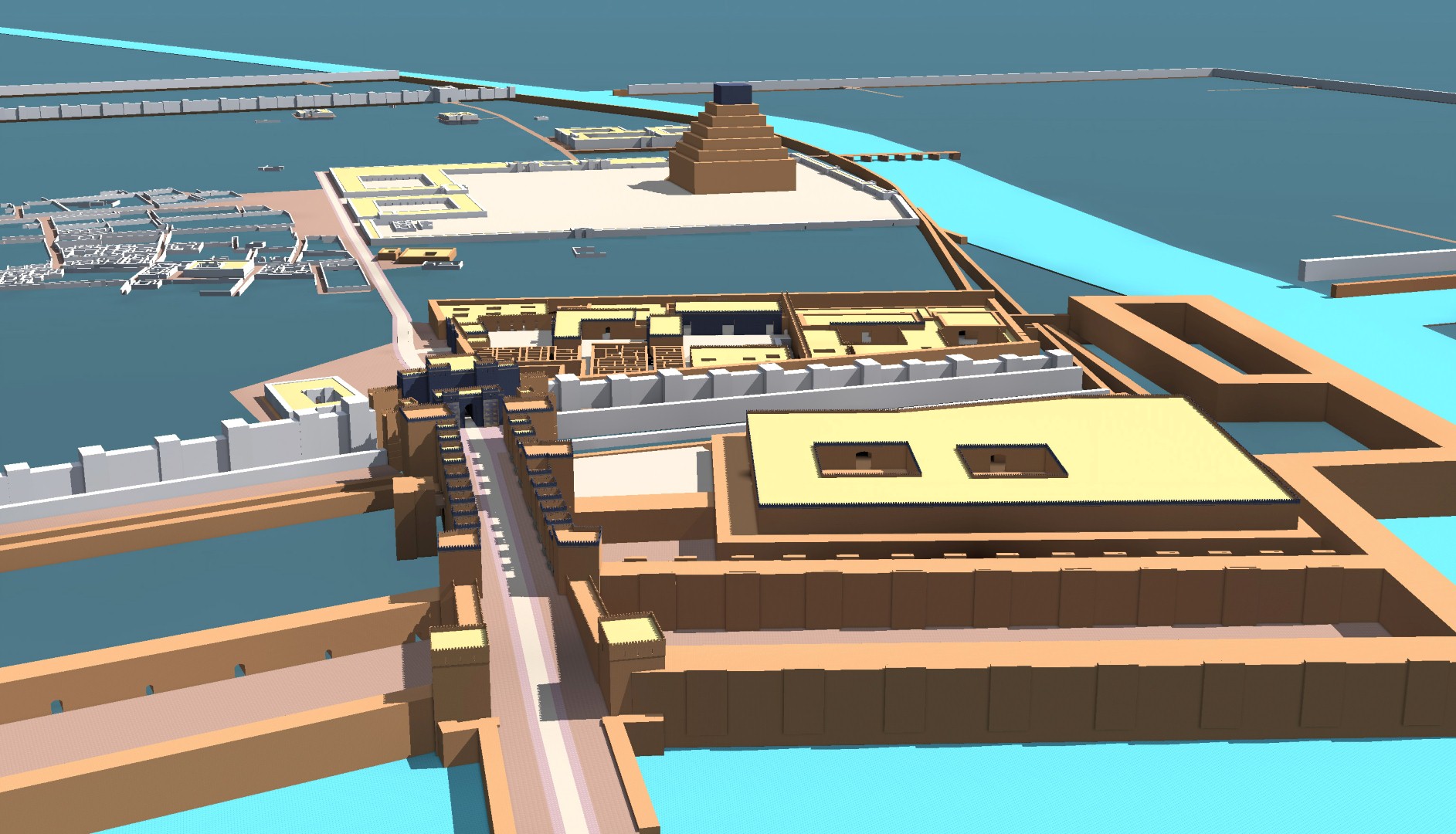This project investigated the function(s) of oversized building projects in the Ancient Near East. Research was conducted into the logistical and economical aspects involved in implementing large-scale building projects and references the cuneiform archives of the 3rd and early 2nd millennium BC and the monumental expansion of the city of Babylon that took place under the reign of king Nebuchadnezzar II (604-562 BC).
Research

Middle of Babylon, the end of the reign of Nebuchadnezzar II around 562 BC; © Olof Pedersén
Monumental construction projects are known to have been carried out in many regions and periods of the history of the Ancient Near East; the city wall of Uruk, the Tower of Babylon and the aqueduct of Jerwan are only the most famous examples. Excavations and texts indicate that XXL-undertakings actually represent a paradigm of the free state in Mesopotamia. Especially the errection of large sanctuaries and temple complexes as well as their continous maintenance, restauration and successive enlargement played a most important role in the Mesopotamian societies and was one of the ruler’s paramount duties.
In the research group XXL – Monumentalized Knowledge a set of criteria has been identified at least some of which have to be met in order to qualify a buildig project as “monumental” in opposition to “just big”. One of them is that the project involved an extremely large investment relative to the economic (and / or technical) potential of the society in question. It is first and foremost this aspect of monumentality that it was addressed in the research of B-2-2 on extra large building projects in Mesopotamia.
Results
This research was conducted in two subprojects. In the first subproject (terminated) the members of the project analyzed the rich administrative text corpus of the Ur III Period (around 90,000 published texts) and the mathematical records from the subsequent Old Babylonian period (and later on) in order to obtain a detailed quantitative picture of the different logistical issues involved and finally managed to derive a thorough general estimate for work expenditures and the total costs of an XXL building project. In a case study, these results have been applied to investigate the rebuilding of the ziggurat of Uruk in the 21st century BC under king Ur-Namma (2112–2095 BC). One of the most striking and amazing results of this analysis is the fact that such extra large building projects were far less expensive than expected and did in no way overduely burden the Neo-Sumerian state economy.
The second subproject bear on a concrete building project: the expansion of the city of Babylon under king Nebuchadnezzar II (604-562). Here the relevant logistical and economic questions are adressed on the basis of the Neo-Babylonian managerial texts on the “large-scale building site Babylon” and the copious archaeological evidence collected by Olof Pedersén that enters a 3D model of Babylon. The results of both subprojects were tested against the evidence from the much younger period as to prove whether and to what degree transferability and thus generalization is possible.
Results from the B-2-2 project have been presented on scientific conferences like:
- the 61st Rencontre Assyriologique Internationale in Geneva and Bern 2015 (H. Brunke);
- the Querschnittskolloquium Groß Bauen at BTU Cottbus-Senftenberg 2015 (H. Brunke);
- The International Conference of Sociologists Filling the Void. Religion and the City TU Darmstadt 2016 (E. Cancik-Kirschbaum);
- The International Conference Under Construction at TU Stuttgart 2013 (E. Cancik-Kirschbaum);
and to the general public:
- within the lecture series Großbauten in ihren Gesellschaften – zwischen praktischer Nutzung und symbolischer Bedeutung in the winter term 2015/16 (organized by our Topoi research group B-2) at FU Berlin (E. Cancik-Kirschbaum)
- in the VDI series Praktiken und Potenziale der Bautechnikgeschichte (H. Brunke).
- in the series Kulturelle und Technische Werte at BTU Cottbus 2015 (E. Cancik-Kirschbaum)
- in the lecture series Modellkaiser – Kaisermodell at FU Berlin 2015 (E. Cancik-Kirschbaum)
Several comments and interviews have been given to newspapers.
The results were published within the framework of research project B-2 joint article: “Thinking Big. Research in Monumental Constructions in Antiquity”, in: Space and Knowledge. Topoi Research Group Articles, eTopoi. Journal for Ancient Studies, Special Volume 6 (2016).
Furthermore, they were presented to a larger public in the Special Volume “Antikes Wissen” of the magazine “Spectrum der Wissenschaft”:
- Hagan Brunke and Eva Cancik-Kirschbaum, “Grösse hat ihren Preis”, in: Das Wissen der Antike. Spektrum der Wissenschaft Spezial – Archäologie, Geschichte, Kultur, Spektrum der Wissenschaft, 4/2017 (Dec 2017), 8–13
- Hagan Brunke, “Quadratische Gleichungen – in Keilschrift”, in: Das Wissen der Antike. Spektrum der Wissenschaft Spezial – Archäologie, Geschichte, Kultur, Spektrum der Wissenschaft, 4/2017 (Dec 2017), 14–15
